

Realistic revitalization: Students help create a new vision for a historic Hamilton neighborhood
By Shavon Anderson, university communications and marketing
Standing at the corner of Fourth and Walnut streets, Radhames “Rady” De Leon surveys the old houses, small businesses and worn streets near the heart of Hamilton’s 2nd Ward. He leans against a crumbling ledge belonging to the former Neal’s Cafe. Neal’s closed a few years back for a space close to the city’s central business district.
“A lot of people wish they would have stayed,” De Leon said. “Honestly, I think it was just a better business opportunity.”
It’s been months since the Miami University senior walked these streets. On this day, his visit is reflective and hopeful. In February, the city of Hamilton approached Miami’s department of geography about developing a proposal to revamp the struggling ward. De Leon and 10 other students in advanced urban planning took on the project. He starts describing the class’s ideas when an older man, who’s been in the neighborhood for about 60 years, rides up on a bicycle.
“I’m nosy,” the man said with a smile.

Rady and a longtime Hamilton resident discuss revitalization plans for the community (photo by Scott Kissell).
A block behind them at 732 Central Ave. sits a bold, red building with an empty side lot. It’s an ideal space for a large mural overlooking an urban garden where residents can access free, fresh produce. Inside, there’s room for a small shop and tenants. The man cuts in.
“Tell me something,” he said to De Leon, “If you needed something, would you wait for someone else to do it for you? What are we really doing to make it happen?”
“Accountability,” De Leon responds. “I got you.”
There’s added pressure attached to the student project that comes after years of neglect has left residents both passionate and skeptical about change. The scope of the plan focuses on the improvement of existing properties, new business attraction and improved amenities, but the challenge is maintaining the community’s character and ensuring its residents have a voice.
There’s also pressure in the fact that De Leon has personal ties to the neighborhood, having stayed on and off with family in a housing project on Second Street for years. He intentionally chose to work on the Hamilton proposal when students had their choice of communities to work in for the semesterlong project. It’s his chance to give back.
As if on cue, a car pulls up at the corner where the men are chatting, and one of De Leon’s old neighborhood friends gets out. They share a hug, a handshake and briefly catch up.
“Get a picture of us,” De Leon said.
After lingering for a few minutes, all three men part ways, and De Leon starts walking down the block toward a section of town that used to be like home.
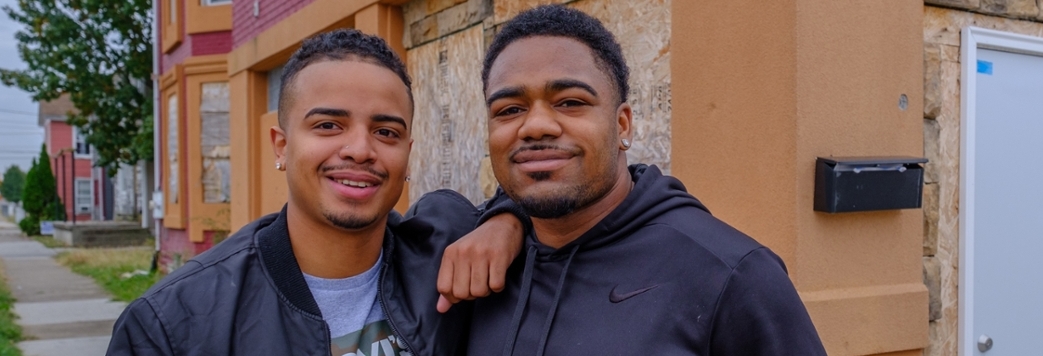
Rady and a neighborhood friend (photo by Scott Kissell).
Earning trust in an overlooked community
Blighted. Run down. Littered.
“When you think of the perfect aesthetics of neighborhoods, this is the complete opposite,” De Leon said.
Although true throughout most of the 2nd Ward, the harsh descriptions still sting for Chamina Curtis who remembers a different time. Curtis, an associate professor of commerce at Miami University Regionals, was born and raised in Hamilton’s Riverview neighborhood. Her family owned a well-cared-for home, her aunt lived next door, and she knew most families on the block.
"People knew who you were or who your family was just by your last name," she said. "You identified with legacy and generations."
Back then, a thriving African American middle class created economic stability, a consistency she saw through the early ’80s. Her community remains one of the city’s most diverse as an emerging Hispanic population rivals the historically black neighborhood. But ask her when things shifted, and she can’t be sure. She points to noticeable changes by the early 2000s. Today, issues are glaring.
"Even my childhood home, a lot of these properties are in disrepair," she said. "Why is this allowed to happen?"
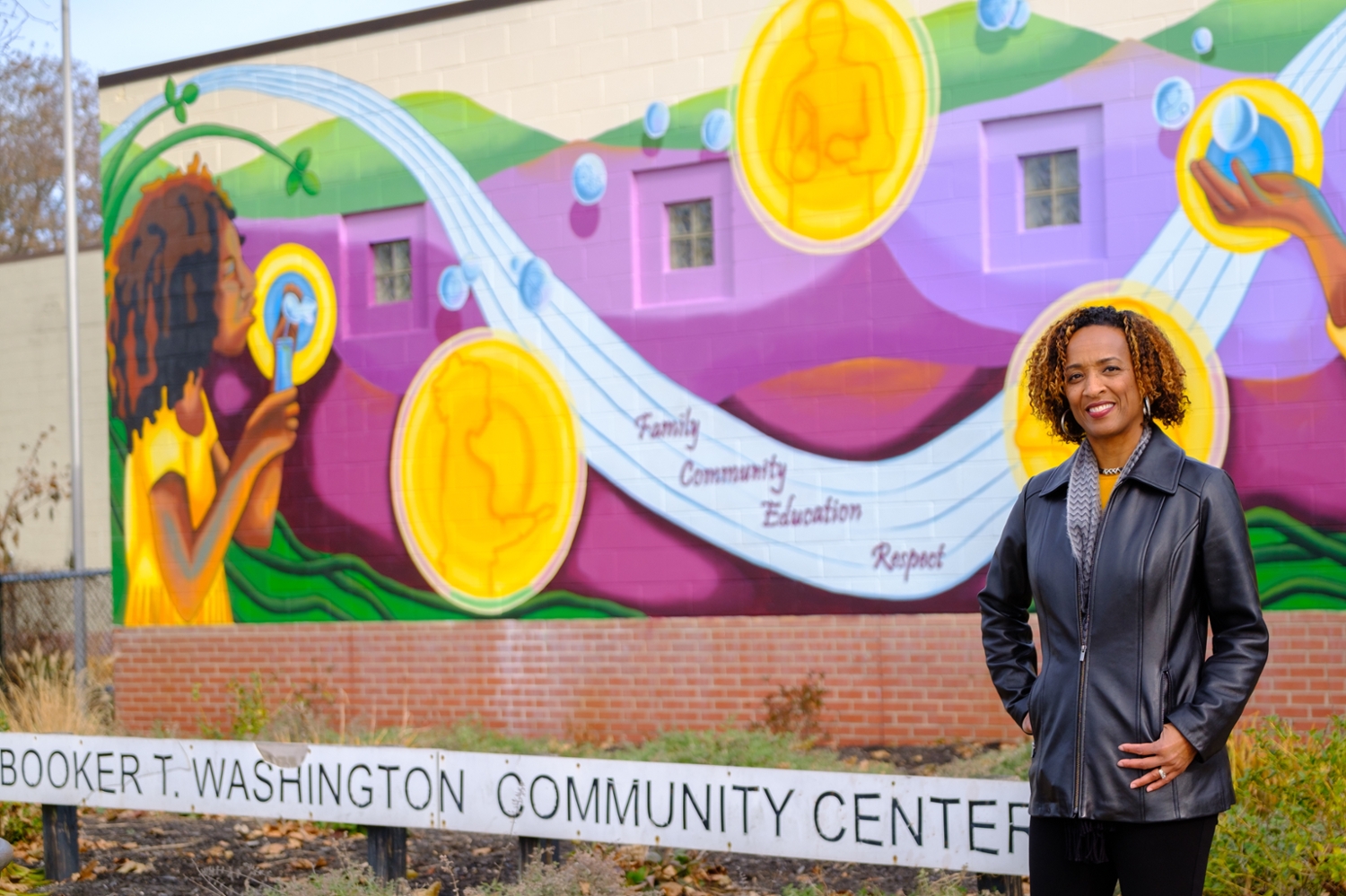
Chamina Curtis (photo by Scott Kissell).
About five years ago, Curtis’ frustration reached its peak as access to stable, well-paying jobs declined and longtime residents relocated. While many pointed blame at the city, she got involved.
She now serves as board chair for the Booker T. Washington Community Center and as a trustee for the YMCA. She also sits on the strategic planning committee for the Southeast Civic Association. Through her activism, she learned about the student community improvement project, which coincided with a 5-week economic series she spearheaded with the city and organizations from the Riverview and Jefferson neighborhoods.
“I suggested that the students come to a meeting,” Curtis said.
That’s where she reconnected with De Leon for the first time in years. Curtis taught De Leon at Miami Regionals in 2017 before he transferred to the Oxford campus. She said De Leon, a Dominican college kid with authenticity and respect, broke through residents’ initial distrust.
“Just his whole style,” Curtis remembered. “You know when you meet someone and there’s just something about them you like? There was that connection.”
Throughout the spring semester, the class took walking tours of the ward to inventory properties and survey potential spaces while hearing personal stories and incorporating feedback from families. Using Post-it’s, markers and charts, residents engaged in a workshop where they listed words they wanted to describe the 2nd Ward’s future. Another exercise identified strong and weak community areas on a map.
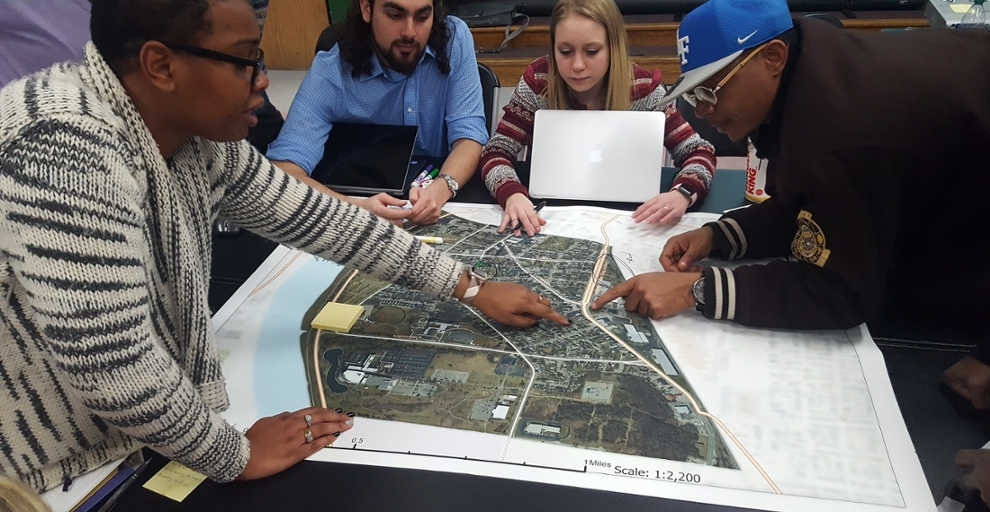
Miami students lead a workshop with Hamilton residents to get input from those directly affected by the proposal (photo by the department of geography).
During the process, Daniel Tidyman (Miami ’16), associate city planner for Hamilton, served as a liaison between students and community and city leaders. Tidyman, who’s been with Hamilton for more than two years, arrived eager to facilitate expansion. Now with increasing development and the upcoming $200 million Spooky Nook sports complex, his job includes making sure the 2nd Ward isn’t left behind. Tidyman checked in with students to ensure certain markers were met and coordinated key meetings with stakeholders.
Community input informed the development of the project goals and became the basis for recommendations. As the class began drafting concrete ideas, De Leon’s input proved a critical voice.
"In my group, I was the only one who's been in that socioeconomic bracket for most of my life," he said. “I remember we talked about putting a big lake in one of these vacant lots. I had to give them my point of view. We’re going to tell someone who’s poor that we’re putting a lake in your neighborhood, but not important amenities? The challenge was getting them to understand.”
By May, a final proposal included upgrades to pedestrian safety crosswalks and street lighting, signage, vibrant murals and community green spaces, ways to flip abandoned properties and information on how to leverage economic programs like Hamilton CORE and federal Opportunity Zones.
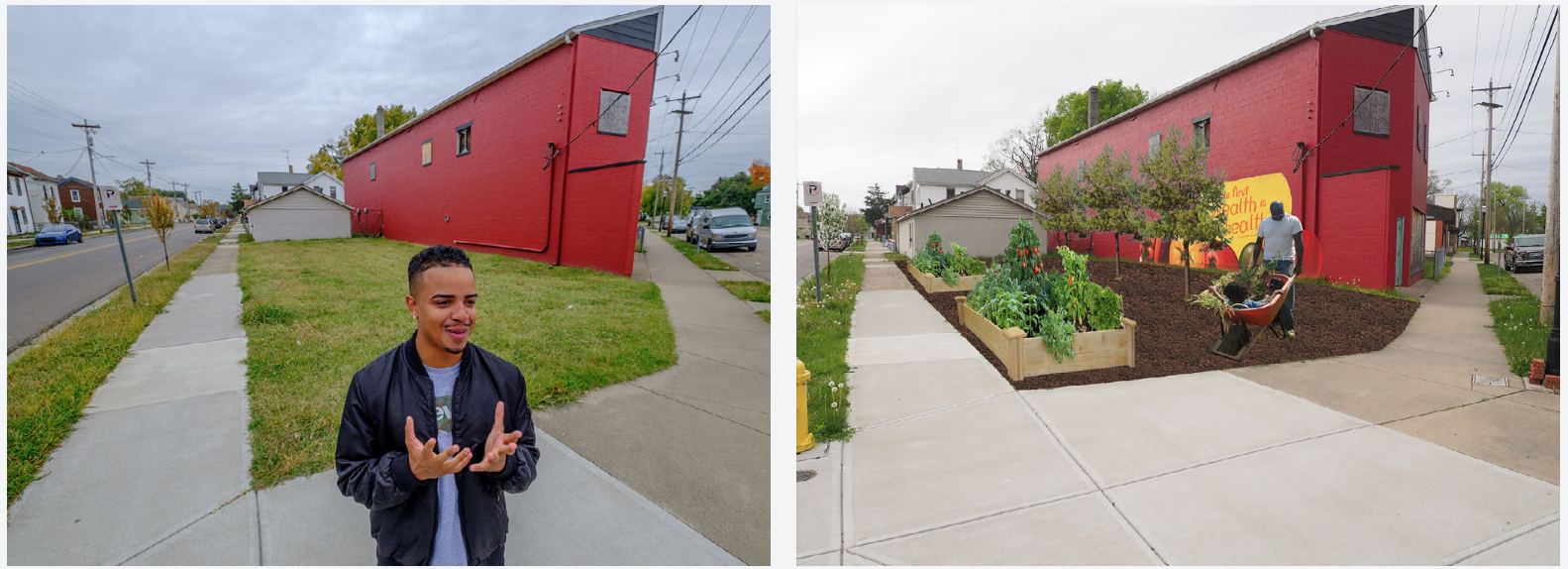
Left: Rady stands in front of a present-day building on Central Avenue. Right: Renderings of proposed changes include a mural and urban garden (photos by Scott Kissell and the department of geography).
“I don’t think people understand how important it was having someone in the class that reflected people in the neighborhood,” Curtis said about De Leon.
She also credits the entire class with how they conducted themselves, noting that their approach helped reshape residents’ attitudes.
“It wasn’t the city coming in and making these decisions,” she said. “It was a class working with the community and saying, ‘We value your opinion.’’
More than a grade
To David Prytherch, professor of geography, community engaging, client-based work is the foundation of a curriculum that prepares students to deal with the complexities of urban planning.
“These kinds of classes are not easy to teach because the stakes are high for everyone,” he said. “These are real-world clients, and the projects have real-world consequences.”
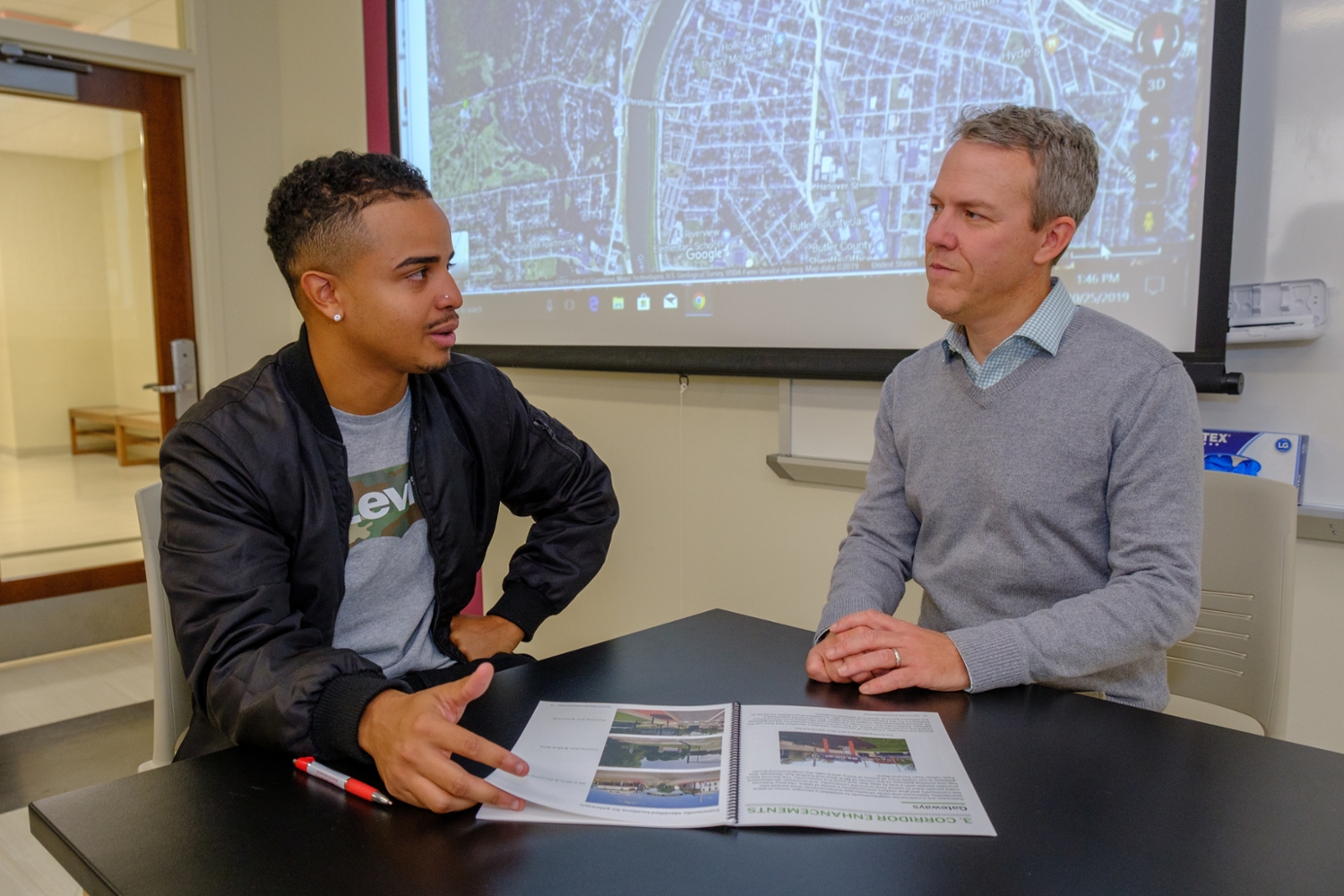
Rady and David Prytherch, professor of geography, discuss the final proposal (photo by Scott Kissell).
Prytherch said things got off to a rocky start during an intense first community meeting, but mutual trust eventually developed to create a tangible vision.
Not only did Prytherch’s students work to develop a successful proposal, they connected to future careers. Tidyman, who had Prytherch as a professor, credits the instructor as being a major influence in his decision to pursue urban planning. The alumnus served a unique role for the class having worked for clients as a student to becoming a client and advising students from a professional lens.
It’s a balance of risk and reward, especially working with a historical community like the 2nd Ward, but one that Prytherch said pays off when families benefit long term.
“Planning can be messy, but now the neighborhood and Hamilton are working to implement a consensus plan,” he said. “What more can you ask of a learning experience?”
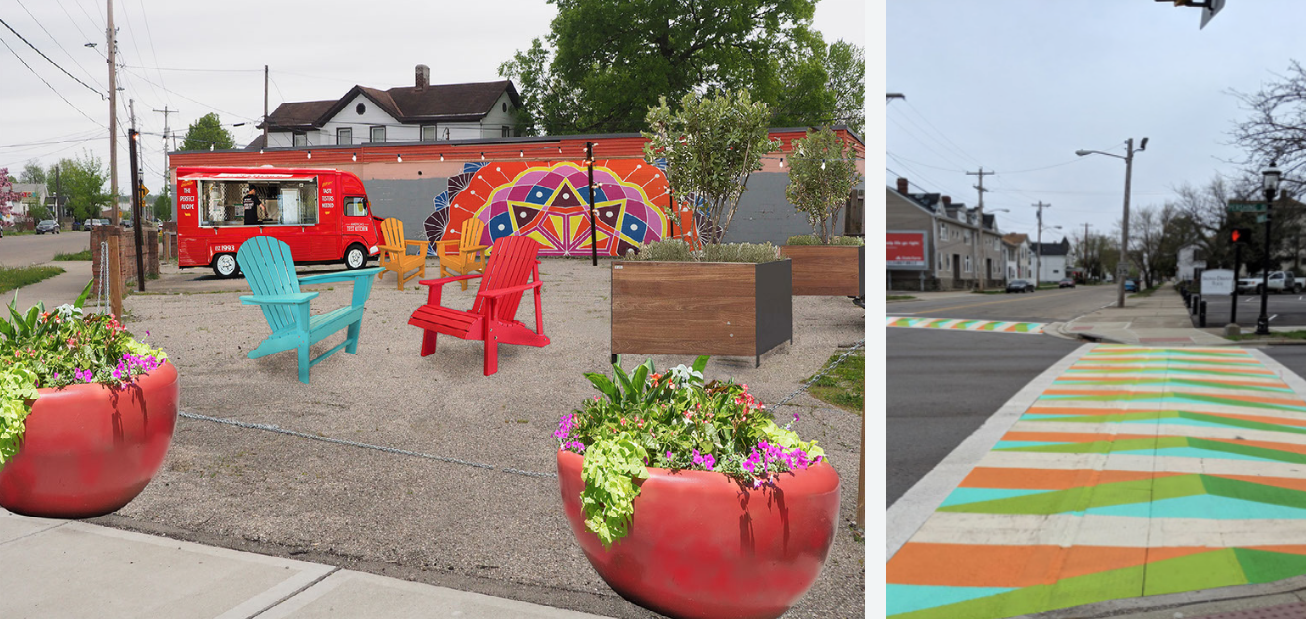
Left: Rendering of a proposed gathering space at Central Avenue and Walnut Street. Right: Rendering of a proposed crosswalk at Pershing Avenue and Second Street that would increase vibrancy and pedestrian safety (photo by the department of geography).
Curtis is excited to bring in viable resources and job opportunities to help families gain economic stability.
“Many in the community understand that in order to have sustainable economic development, we need to have safe, clean and engaged neighborhoods,” she said. “We need gathering spaces, small businesses and beautification, and the student proposal speaks to all of that.”
As December graduation nears, De Leon likely won’t be around for the plan’s long-term rollout, but he’ll be close enough to check in on progress for the time being. He’s secured a full-time position as a Cincinnati-based project manager with Ryan Homes. His career goals involve potential real estate development and management, working to rehab properties in communities like Hamilton.
“I heard the city accepted the proposal,” he said with pride. “It’s a sense of fulfillment. We’re really doing right by these families.”
The Miami plan was adopted by Hamilton City Council in October and went into effect in November. It’s now included in the city’s comprehensive plan, Plan Hamilton.
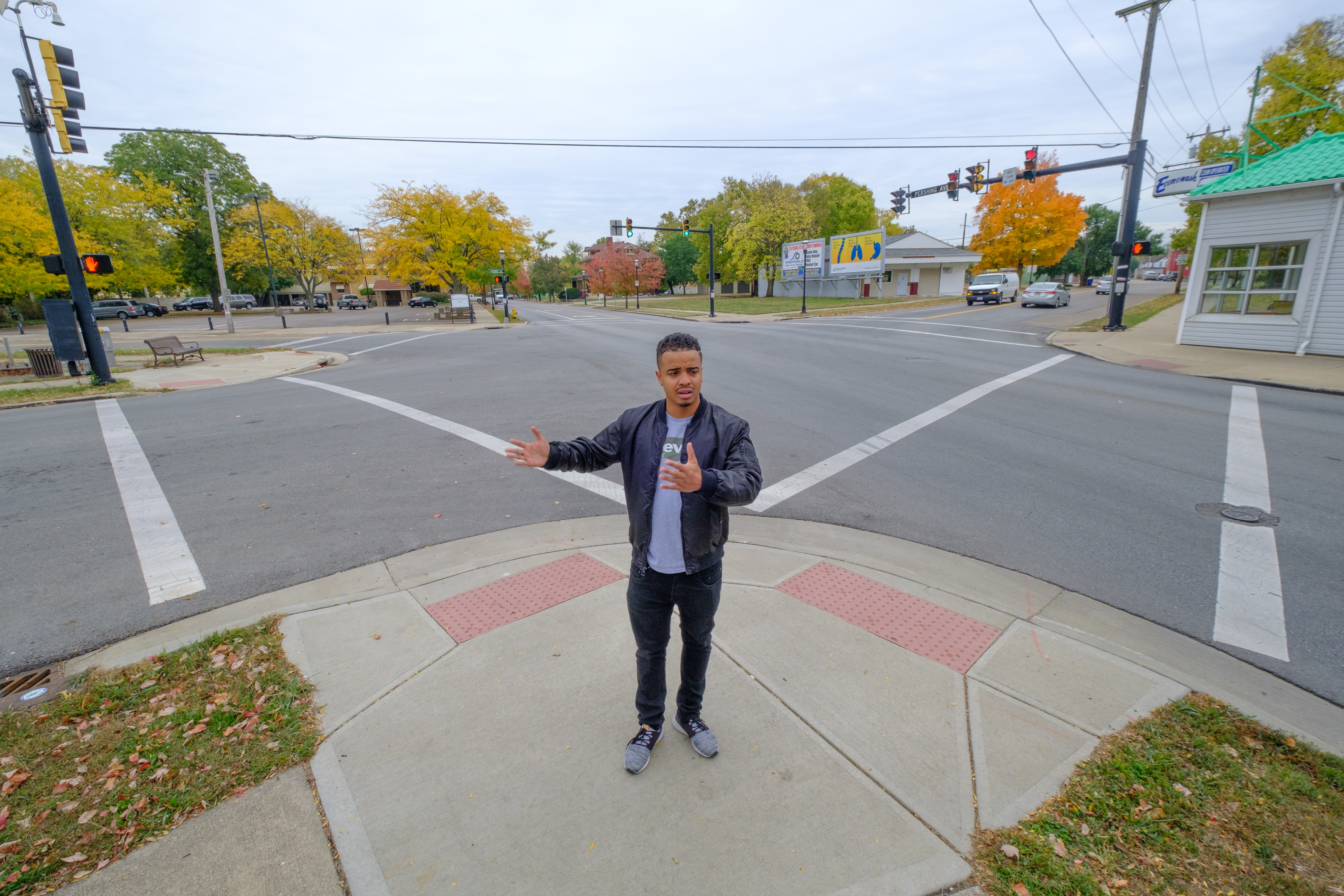
Rady explains investment ideas while standing at the Five Points intersection (photo by Scott Kissell).
Walking past empty lots and for-sale signs near Pershing and Central avenues, De Leon is eager to see the community collaboration come to life.
“There’s a big gap over there, in between those houses,” he said, pointing up the block. “There’s an old retail spot that used to be there, too.”
He stops at the Five Points intersection – the location for a proposed drug store, new residential developments, retail and restaurants – looks around and smiles.
